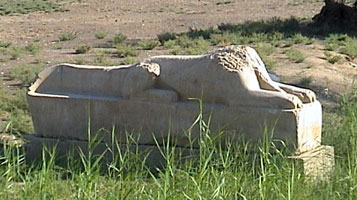
The Mortuary Temple of Amenhotep III (Kom el-Hettan) is located in the West Bank directly across the Nile from Thebes. Built by the Eighteenth Dynasty pharaoh Amenhotep III, it was the largest mortuary temple in the Theban necropolis, larger even than the complex of Karnak at that time. It covered an impressive 350,000 square metres.
The temple was the cult centre for the worship of Amenhotep III as a god both before and after his death. The architect of the temple was the respected named Amenhotep, son of Hapu.
The temple is aligned to face east, towards the Nile. The Colossi of Memnon flanked the entrance and behind them two large courts and three mudbrick pylons led to a solar court. Within the two courts two further seated statues of Amenhotep III were found along with a headless sphinx (thought to represent Queen Tiy), another sphinx with the body of a crocodile, statues of jackals (no doubt representing Anubis) and statues of Amenhotep III as Osiris.

A further series of sphinx led from the third pylon to the solar court which was contained by sandstone papyrus topped columns and statues of Amenhotep III as Osiris. On these statues were inscribed lists of captives from foreign lands (although the reign of Amenhotep II was not known for military conquest). On the south side of the entrance to the solar court a massive stele depicted Amenhotep III and Queen Tiy with Ptah–Sokar–Osiris. The text on the stele lists the building works of Amenhotep III.

The concept behind the temple was brilliant, but flawed. It was purposely built close to the river so that the Nile would flood its precincts every year with only the inner sanctum remaining above the water. The inner sanctum represented the primeval mound and every year the temple would emerge from the waters, just as it was believed the earth had emerged from the waters of chaos.
Unfortunately, because the temple was constructed so close to the river it suffered irreparable water damage, and by the Nineteenth Dynasty it was already in ruins. This proved too tempting for later builders and so much of the masonry was recycled into other building projects. For example, a large granite stele from this temple was placed within the mortuary temple of Merenptah.
All that remains of this great monument is a small number of scattered, ruined statues and the two colossal statues known as the Colossi of Memnon.
Copyright J Hill 2010